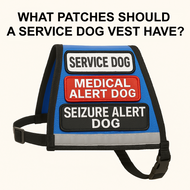What Patches Should a Service Dog Vest Have? – ADA Guidance & Options
Posted by WorkingServiceDog on Sep 1st 2025
One of the most common questions we hear from handlers is: “What patches should I put on my service dog’s vest?” The short answer: it depends on your dog’s role and how much information you want to share with the public.
Are Patches Required by the ADA?
Under the Americans with Disabilities Act (ADA), service dogs are not required to wear any vest, patch, or special identification. Staff may only ask two questions if the need for a service animal is not obvious:
-
Is the dog a service animal required because of a disability?
-
What work or task has the dog been trained to perform?
That said, many handlers find patches helpful. They communicate the dog’s role quickly, reduce interruptions, and reinforce the professional appearance of a working team.
Popular Patch Options
✔ Service Dog – Full Access Patch
The most straightforward choice, this patch makes it clear your dog is a working service animal.
✔ Medical Alert Dog Patch
If your dog assists with a medical condition, this patch directly signals their task and answers the ADA question.
✔ Seizure Alert Dog Patch
For handlers with seizure disorders, this patch communicates the dog’s trained role and importance.
✔ Diabetic Alert Dog Patch
Specifies the dog’s task in monitoring and alerting for diabetes-related conditions.
Directional Patches
Some handlers also use patches that give simple directions to the public. These don’t describe a medical task but help manage interactions in public spaces.
✔ Working Dog – Do Not Pet Patch
Keeps the public from distracting your dog while they are working.
✔ In Training Patch
Lets others know your service dog is still in training, which can help set expectations in public settings.
✔ Please Ask to Pet Me Patch
For handlers who allow contact in certain settings, but only with permission.
Where to Place Patches
Most vests allow for patches on both sides, and some also have the space to fit one on the top. Placement is flexible, but patches should be:
-
Large enough to be easily read in public
-
Positioned where they can be seen from all sides
-
Secured firmly by sewing so they don’t curl or lift
Pairing Patches with the Right Vest
The vest you choose determines how many patches can fit. For example:
-
Mesh vests (lightweight and breathable) easily fit two or more patches.
-
Padded vests (more structure) often can fit multiple patches on the sides and top.
-
Small dog vests (lightweight) should have bold patches for high visibility.
Explore our full collection of Service Dog Vests to find the vest style that’s most comfortable for your dog and best suited for patch placement.
Final Thoughts
No patches are legally required, but the right ones make public access smoother by clearly communicating your dog’s role. Whether you stick with a broad “Service Dog” patch, use task-specific options like Medical Alert, Seizure Alert, or Diabetic Alert, or add directional patches such as Do Not Pet or In Training, patches help set expectations and keep focus on your partnership.

